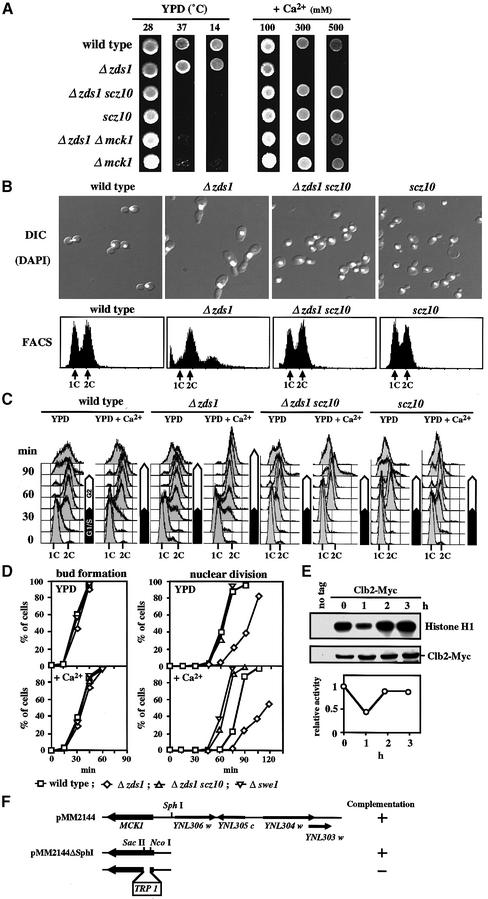Fig. 1. The scz10 mutation suppresses various phenotypes of the Δzds1 strain. (A) Effect of scz10 (mck1-1) on the growth of the Δzds1 mutant strain on solid medium. Wild-type (DHT22-1b), Δzds1 (YAT1), Δzds1 scz10 (YMM2144), Δzds1Δmck1 (YMM69), scz10 (YMM22) or Δmck1 (YMM68) cells were spotted on YPD plates and grown at 28°C (2 days), 37°C (2 days) or 14°C (4 days), or on YPD plates supplemented with the indicated concentration of CaCl2 and incubated at 28°C for 2 days. (B) Cell morphology (DIC), DAPI fluorescence image and flow cytometry analysis of PI-stained cells (FACS: 1C, one DNA copy; or 2C, two DNA copies) of various strains after 6 h of incubation with 100 mM CaCl2 at 28°C. (C) DNA content during cell cycle progression in various strains. Early log phase growing cells (OD600 of 0.2–0.3) of DHT22-1b, YAT1, YMM2144 or YMM22 strains were synchronized with α-factor in G1, and resuspended in YPD or YPD plus 50 mM CaCl2. Samples were taken 15 min after removing α-factor. (D) Quantification of the cumulative percentage of bud formation and nuclear division in the cell cultures prepared as in (C). For comparison, the data with Δswe1 (YMM5-8c) are shown. Open squares, DHT22-1b; open diamonds, YAT1; open triangles, YMM2144; inverted open triangles, YMM5-8c. (E) Inhibition of Clb2–Cdc28 activity by CaCl2 in vivo. CaCl2 was added to a final concentration of 100 mM to early log phase culture of wild-type cells expressing (TMY310) or not expressing (DHT22-1b) Clb2-Myc in YPD at 28°C, and incubated further. The cell extracts prepared were immunoprecipitated with anti-Myc and assayed for histone H1 kinase acitivity. In parallel, cell extracts were immunoprecipitated with anti-Myc antibody, separated by SDS–PAGE and detected with Clb2-Myc. Activity was normalized relative to the Clb2 level of each lane. Activity was expressed relative to the activity at time zero (=1.0). (F) Map of the insert ORFs in plasmid pMM2144, which fully complemented the scz10 mutation. Deletion analysis was carried out to localize the suppressor activity (indicated by the + sign).

An official website of the United States government
Here's how you know
Official websites use .gov
A
.gov website belongs to an official
government organization in the United States.
Secure .gov websites use HTTPS
A lock (
) or https:// means you've safely
connected to the .gov website. Share sensitive
information only on official, secure websites.
